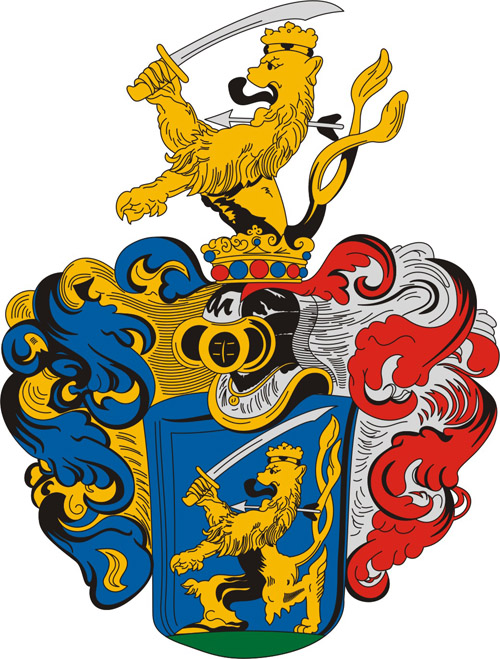
(Zala megye)
Kék mezőben jobbjában ezüst szablyával, ha kell lesújtani készülő, bal kezét (mancsát) védelmezően kinyújtó, nyelvét kiöltő, szemét haragosan ráncoló – a koronafőből kiemelkedő oroszlánon jól kivehető – nyakán ezüst nyíllal átszegett (átlőtt) kettős farkú koronás arany oroszlán látható, amely jobb lábát erősen (keményen) megveti a zöld pajzs talpon – ez utalhat a bakonyi erdőségre.
A nyitott sisakrostély fölött a magiszteri fokozatra utaló „M” látható, egyben megtalálható a magiszteri arany lánc. A takaró utal arra, hogy a címert az utódok készítették. Kék-arany, vörös-ezüst heraldikai fejlődés a 16. századtól kezdett elterjedni.
A rangjelző gyöngyös – leveles arany koronából a címerpajzsban található arany oroszlán ágaskodik ki – részben megismételve a címerpajzs alakját.
Oroszlán módjára védte a dinasztiát, az oroszlán a magyar történelemben általában törzsfők és nemzettség fők címerállata volt, az ő kiváltságuk volt címerállatként használni.
II. Andrástól elévülhetetlen érdeméért kaphatta és használhatta ezen címerpajzsot. Oroszlános címer.
Salomvár címeréről:
Salamon magiszter és leszármazói címere:
Katona József érdemes művének a Bánk bánnak Miska vasvári ispán fiának, Salom mesternek és utódainak címere.
A címer szerző ős érdemeit jeleníti meg – a falut alapító Salamon magiszter címer pajzsa – és a jelenlegi állapotban látható címert utódai készítették, erre utal a kétszínű és két fémszínű „heraldikai” takaró.
Magiszter Salamon a csallóközi de genere Salamon nemzettség tagja.
- Eszterházy, Illésházy, stb. család is e nemzettség leszármazói –
IV. Béla király nevelőjének II. András és az ország első ismert tárnok mesterének címere (a címerpajzs) Gertrúd királyné meggyilkolásakor, a válságos időben, mint a trón várományosának, Béla hercegnek a nevelője, Bélát a Bakony rengetegében lévő családi birtokukra menekítette, ….. későbbiekben II. András, IV. Béla ifjabb király mellé rendeli Horvát-Szlavon-Dalmát bánság kormányzásában, mint bán. Tárnokmesterként és bánként az ország zászlós urai közé tartozik./1213. comes curialis/
(The County of Zala)
Shield erect and azure. Its main charge is a lion or statant and rampant, langued, its forehead is wrinkled in anger. The lion’s head is adorned with a crown, its tail bifourchée, its neck is pierced with an arrow argent. In its dexter paw beast is holding a scimitar argent, its sinister paw is held out in defense, but, if necessary, he is ready to strike with it. With its dexter foot lion is holding firmly to the base vert. Tincture vert (green) is a reference to the densely wooded areas of the Bakony region.
Above the open grid of the helm the letter ’M’ is inscribed, which is a reference to the word magistrate. The magistrate’s chain is also part of the charges of the shield. Mantling is a reference to the fact that the coat of arms of the settlement was created by a new generation of its magistrates. The tinctures azure and or, as well as argent and gules began to spread in heraldry as late as the 16th century.
From the crown of rank, or, verdured and adorned with pearls, the figure of a lion or is issuing, the same motif, which is originally borne in the shield of the settlement’s coat of arms.
In Hungarian history the lion used to be the heraldic beast of tribal chiefs, who fiercely used to defend the members of their dinasty. Thus the descendants of tribal chiefs were allowed to use lions as charges in their coats of arms.
The settlement might have been awarded the original of its present-day coat of arms by King András II.
The coat of arms of Salomvár used to belong to Magister Solomon and his successors. This fact appears int he work of Hungarian writer József Katona, who wrote Hungary’s national tragedy, entitled Bánk bán. In this drama he mentioned Bailiff Miska as well as Magister Solomon. This latter person founded the village of Salomvár.His successors created the settlement’s present-day coat of arms, as it is attested by the relatively modern and colourful mantling. Magister Solomon belonged to the Solomon clan of the Csallóköz region. The members of the well known Eszterházy and Illésházy families also take their origin from this clan.
Magister Solomon was the tutor of King Béla IV and a courtier of King Andrew II. In the hard times when Queen Gertrúd was murdered it was him who helped Prince Béla to escape and Solomon hid him on his estate, located in the middle of the Bakony’s deep forests. Later András II hired him as vice governor of Croatia, Slavonia and Dalmatia and thus he assisted the young king Béla IV with his duties as governor of the previously mentioned estates. Magister Solomon was one of the best known noblemen in the country. (1213: comes jurialis).